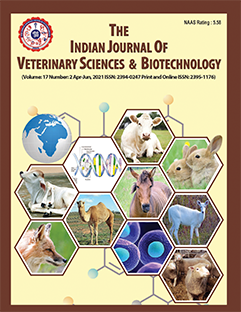Botanical Defence: Exploring Plant-Derived Vaccines for Animal Health – An Overview
DOI:
https://doi.org/10.48165/ijvsbt.21.4.01Keywords:
Antigens, , Bioreactors, Cost-effective, Goats, Plant-based vaccinesAbstract
Plant-based vaccines have emerged as a revolutionary approach in the field of immunization, offering numerous advantages over conventional vaccine production methods. This article explores the concept of plant-derived vaccines and their potential applications in animal health and sustainable agriculture. Utilizing plants as bioreactors, plant-based vaccines produce specific antigens that trigger a robust immune response upon ingestion by animals. These vaccines are pathogen-free and do not require refrigeration, making them cost-effective and accessible, especially in resource-limited regions. Moreover, plant-based vaccines are safer than traditional vaccines, as they contain no live pathogens, and they have demonstrated high stability and scalability in antigen production. Maintaining dosage consistency and adhering to Good Manufacturing Practice (GMP) standards are essential for ensuring vaccine quality and efficacy. Plant-based vaccines represent a paradigm shift in vaccine production and offer a pathway to a healthier and more resilient future. With further advancements and collaboration among stakeholders, plant-based vaccines have the potential to impact global health, addressing disease challenges in animals and humans alike.
Downloads
References
Azegami, T., Yuki, Y., & Kiyono, H. (2014). Challenges in mucosal vaccines for the control of infectious diseases. International Immunology, 26(9), 517–528.
Chen, J., Wang, L., Chen, J., Huang, J., Liu, F., Guo, R., ... & Tian, M. (2018). Agrobacterium tumefaciens-mediated transformation system for the important medicinal plant Dendrobium catenatum Lindl. In Vitro Cellular & Developmental Biology - Plant, 54, 228–239.
Chen, Q., & Lai, H. (2015). Gene delivery into plant cells for recombinant protein production. BioMed Research International, 2015(1), 932161.
Concha, C., Cañas, R., Macuer, J., Torres, M.J., Herrada, A.A., Jamett, F., & Ibáñez, C. (2017). Disease prevention: An opportunity to expand edible plant-based vaccines. Vaccines, 5, 14.
Fujiki, M., Kaczmarczyk, J.F., Yusibov, V., & Rabindran, S. (2008). Development of a new cucumber mosaic virus-based plant expression vector with truncated 3a movement protein. Virology, 381(1), 136–142.
Garcia-Alonso, M., Hendley, P., Bigler, F., Mayeregger, E., Parker, R., Rubinstein, C., ... & McLean, M.A. (2014). Transportability of confined field trial data for environmental risk assessment of genetically engineered plants: A conceptual framework. Transgenic Research, 23, 1025–1041.
Gomez, E., Zoth, S.C., Carrillo, E., & Berinstein, A. (2010). Developments in plant-based vaccines against diseases of concern in developing countries. Open Infectious Diseases Journal, 4(1), 55–62.
Gomez, E., Lucero, M., Chimeno Zoth, S., Carballeda, J., Gravisaco, M., & Berinstein, A. (2013). Transient expression of VP2 in Nicotiana benthamiana and its use as a plant-based vaccine against infectious bursal disease virus. Vaccine, 31, 2623–2637.
Hefferon, K. (2014). Plant virus expression vector development: New perspectives. BioMed Research International, 2014(1), 785382.
Holmgren, J., & Czerkinsky, C. (2005). Mucosal immunity and vaccines. Nature Medicine, 11(Suppl 4), S45–S53.
Kim, M.J., An, D.J., Moon, K.B., Cho, H.S., Min, S.R., Sohn, J.H., ... & Kim, H.S. (2016). Highly efficient plant regeneration and Agrobacterium-mediated transformation of Helianthus tuberosus L. Industrial Crops and Products, 83, 670–679.
Korban, S.S. (2005). Opportunities and challenges for plant-based vaccines. In Agricultural Biotechnology: Beyond Food and Energy to Health and the Environment, National Agricultural Biotechnology Council, pp. 71–77.
Laere, E., Ling, A.P.K., Wong, Y.P., Koh, R.Y., Mohd Lila, M.A., & Hussein, S. (2016). Plant-based vaccines: Production and challenges. Journal of Botany, 2016(1), 4928637.
Lamichhane, A., Azegami, T., & Kiyono, H. (2014). The mucosal immune system for vaccine development. Vaccine, 32(49), 6711–6723.
Mason, H.S., & Arntzen, C.J. (1995). Transgenic plants as vaccine production systems. Trends in Biotechnology, 13(9), 388–392.
Mestecky, J., Nguyen, H., Czerkinsky, C., & Kiyono, H. (2008). Oral immunization: An update. Current Opinion in Gastroenterology, 24(6), 713–719.
Rigano, M.M., & Walmsley, A.M. (2005). Expression systems and developments in plant-made vaccines. Immunology and Cell Biology, 83(3), 271–277.
Sanford, J.C. (1990). Biolistic plant transformation. Physiologia Plantarum, 79(1), 206–209.
Saxena, J., & Rawat, S. (2014). Edible vaccines. Advances in Biotechnology, 32, 207–226.
Shah, C.P., Trivedi, M.N., Vachhani, U.D., & Joshi, V.J. (2011). Edible vaccine: A better way for immunization. Clinical Trial, 3(1), 1–4.
Sharma, M., & Sood, B. (2011). A banana or a syringe: Journey to edible vaccines. World Journal of Microbiology and Biotechnology, 27, 471–477.
Streatfield, S.J. (2005). Oral hepatitis B vaccine candidates produced and delivered in plant material. Immunology and Cell Biology, 83(3), 257–262.
Streatfield, S.J., & Howard, J.A. (2003). Plant-based vaccines. International Journal for Parasitology, 33(5–6), 479–493.
Su, H., Van Eerde, A., Rimstad, E., Bock, R., Branza-Nichita, N., Yakovlev, I.A., & Clarke, J.L. (2023). Plant-made vaccines against viral diseases in humans and farm animals. Frontiers in Plant Science, 14, 1170815.
Tacket, C.O. (2007). Plant-based vaccines against diarrheal diseases. Transactions of the American Clinical and Climatological Association, 118, 79.
Takeyama, N., Kiyono, H., & Yuki, Y. (2015). Plant-based vaccines for animals and humans: Recent advances in technology and clinical trials. Therapeutic Advances in Vaccines, 3(5–6), 139–154.
Vasil, K., & Vasil, V. (2006). Transformation of wheat via particle bombardment. Methods in Molecular Biology, 318, 273–283.
Wu, J., Yu, L., Li, L., Hu, J., Zhou, J., & Zhou, X. (2007). Oral immunization with transgenic rice seeds expressing VP2 protein of infectious bursal disease virus induces protective immune responses in chickens. Plant Biotechnology Journal, 5(5), 570–578.
Yu, J., & Langridge, W.H. (2000). Novel approaches to oral vaccines: Delivery of antigens by edible plants. Current Infectious Disease Reports, 2(1), 73–77.
Yusibov, V., & Rabindran, S. (2008). Recent progress in the development of plant derived vaccines. Expert Review of Vaccines, 7(8), 1173–1183.
Zhou, J.Y., Cheng, L.Q., Zheng, X.J., Wu, J.X., Shang, S.B., Wang, J.Y., & Chen, J.G. (2004). Generation of the transgenic potato expressing full-length spike protein of infectious bronchitis virus. Journal of Biotechnology, 111(2), 121–130
Downloads
Published
Issue
Section
License
Copyright (c) 2025 Indian Journal of Veterinary Sciences and Biotechnology

This work is licensed under a Creative Commons Attribution-NonCommercial-NoDerivatives 4.0 International License.




